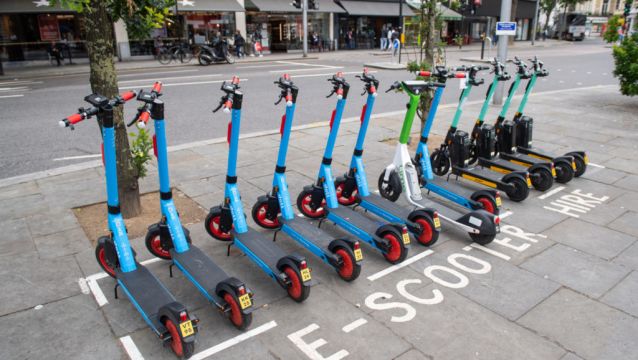An international road safety organisation has called for a 20km/h factory set speed limit for e-scooters and larger wheels as part of a range of common technical standards to be applied to such vehicles across Europe.
The European Transport Safety Council has also recommended that the use of helmets should be made compulsory for using e-scooters, as well as a minimum age of 16.
The ETSC – whose members include the Road Safety Authority in Ireland – has also proposed a ban on the use of e-scooters on footpaths as well as users carrying passengers.
The ETSC said its recommendations were being made in response to the rapid growth of e-scooter usage over the last five years.
In Ireland, a new Road Traffic and Roads Bill which will allow for the regulation of the use of e-scooters is expected to be passed by the Oireachtas by the end of March.
However, it is currently illegal to use e-scooters in a public space.
Gardaí recorded a total of 746 traffic incidents involving e-scooters last year, including 554 collisions, while 305 of the vehicles have been seized since 2020.
The Minister for Transport, Eamon Ryan, said earlier this month that formal drafting of the regulations can begin once the bill has been enacted to create a new class of powered personal transport.
The new report by the ETSC in conjunction with the UK Parliamentary Advisory Council for Transport Safety on safer technical standards for e-scooters has called for a standardisation of rules across Europe “as far as possible” because of the mixed regulatory picture in relation to minimum age, maximum power and speed and use of helmets.
The ETSC said the report had taken into account a wide body of available data including hospital studies, vehicle safety testing and international research.
Potential injuries
They showed that both a rider and pedestrian were likely to suffer severe injuries in a collision with an e-scooter travelling at 20km/h, with the pedestrian more likely to suffer fatal injuries.
Studies estimated that collisions resulting in injury are up to 10 times higher for e-scooter riders than cyclists.
For that reason, the ETSC said it was recommending a factory set speed limit of 20km/h and maximum rated power of 250W.rmong other recommendations proposed are a ban on riding e-scooters while using handheld mobile phones and under the influence of drugs or alcohol.
The ETSC said the number of casualties from collisions involving e-scooters were underreported but studies to date had shown 20-50% of casualties attending hospital had suffered head injuries with very few riders wearing helmets.
In addition, a majority of riders were involved in single vehicle collisions, while intoxication of e-scooter users appeared a problem.
The report also calls for anti-tampering measures to prevent use of e-scooters at unsafe speeds, while they should also have independent front and rear brakes, lights, indicators and an audible warning device.
It suggests there should be a minimum wheel size of 30.5 centimetres on the devices as research had shown there was increased stability with large wheel sizes when going over potholes.
The most common wheel size for e-scooters is currently 20.3cm.
ETSC executive director, Antonio Avenoso, said seriously injured e-scooter riders in hospitals had sadly become common in European cities.
“To break the link between the increased numbers of these vehicles and the increased numbers of injuries, we need some sensible measures to keep riders and other road users safe,” said Mr Avenoso.
He noted e-scooters had a role in creating sustainable cities as they were a transport mode that were much less risky to other road users than cars, vans and lorries.
Mr Avenoso said there was also a responsibility on city authorities to put in place a safer road environment with a network of separate cycle lanes and appropriate speed limits.







